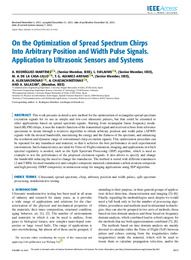Por favor, use este identificador para citar o enlazar este ítem:
https://hdl.handle.net/11000/34215Registro completo de metadatos
| Campo DC | Valor | Lengua/Idioma |
|---|---|---|
| dc.contributor.author | Rodríguez, Alberto | - |
| dc.contributor.author | Svilainis, Linas | - |
| dc.contributor.author | Casa-Lillo, Miguel A. | - |
| dc.contributor.author | Gómez Álvarez-Arenas, Tomás E. | - |
| dc.contributor.author | Aleksandrovas, Arturas | - |
| dc.contributor.author | Chaziachmetovas, Andrius | - |
| dc.contributor.other | Departamentos de la UMH::Ingeniería de Comunicaciones | es_ES |
| dc.date.accessioned | 2025-01-08T09:44:16Z | - |
| dc.date.available | 2025-01-08T09:44:16Z | - |
| dc.date.created | 2021-12-30 | - |
| dc.identifier.citation | IEEE Acces, VOLUME 10, 2022 | es_ES |
| dc.identifier.issn | 2169-3536 | - |
| dc.identifier.uri | https://hdl.handle.net/11000/34215 | - |
| dc.description.abstract | This work presents in detail a new method for the optimization of rectangular spread spectrum excitation signals for its use in simple and low-cost ultrasonic pulsers, but that could be extended to other applications based on spread spectrum signals. Starting from rectangular linear frequency modulated (RLFM) chirps, it uses the transfer function of the transmitted signal and received echoes from reference specimens to iterate through a recursive algorithm to obtain arbitrary position and width pulse (APWP) signals with the desired bandwidth, maximizing the energy and the flatness of the spectrum, and enhancing the resolution and dynamic range of conventional chirp excitation signals. This optimization procedure can be repeated for any transducer and material, so that it achieves the best performance in each experimental environment. Such characteristics are ideal for Time-of-Flight estimation, imaging, and applications in which spectral regularity is needed, such as the Split Spectrum Processing (SSP) algorithm, which is used as example to test the performance of the proposed excitation signals. It also allows to specify and change the bandwidth reducing the need to change the transducers. The method is tested with different transducers (2 and 5 MHz focused transducers) and complex composite materials (aluminum-carbon aviation composite and high porosity GFRP composite) in immersion setup for imaging applications using SSP algorithm. | es_ES |
| dc.format | application/pdf | es_ES |
| dc.format.extent | 15 | es_ES |
| dc.language.iso | eng | es_ES |
| dc.publisher | Institute of Electrical and Electronics Engineers | es_ES |
| dc.rights | info:eu-repo/semantics/openAccess | es_ES |
| dc.rights | Attribution-NonCommercial-NoDerivatives 4.0 Internacional | * |
| dc.rights.uri | http://creativecommons.org/licenses/by-nc-nd/4.0/ | * |
| dc.subject | Ultrasound | es_ES |
| dc.subject | spread spectrum | es_ES |
| dc.subject | chirp | es_ES |
| dc.subject | arbitrary position and width pulses | es_ES |
| dc.subject | split spectrum processing | es_ES |
| dc.subject | nondestructive testing | es_ES |
| dc.subject.other | CDU::6 - Ciencias aplicadas::62 - Ingeniería. Tecnología | es_ES |
| dc.title | On the Optimization of Spread Spectrum Chirps Into Arbitrary Position and Width Pulse Signals. Application to Ultrasonic Sensors and Systems | es_ES |
| dc.type | info:eu-repo/semantics/article | es_ES |
| dc.relation.publisherversion | https://10.1109/ACCESS.2021.3139562 | es_ES |

Ver/Abrir:
116644482.pdf
5,42 MB
Adobe PDF
Compartir:
 La licencia se describe como: Atribución-NonComercial-NoDerivada 4.0 Internacional.
La licencia se describe como: Atribución-NonComercial-NoDerivada 4.0 Internacional.
.png)